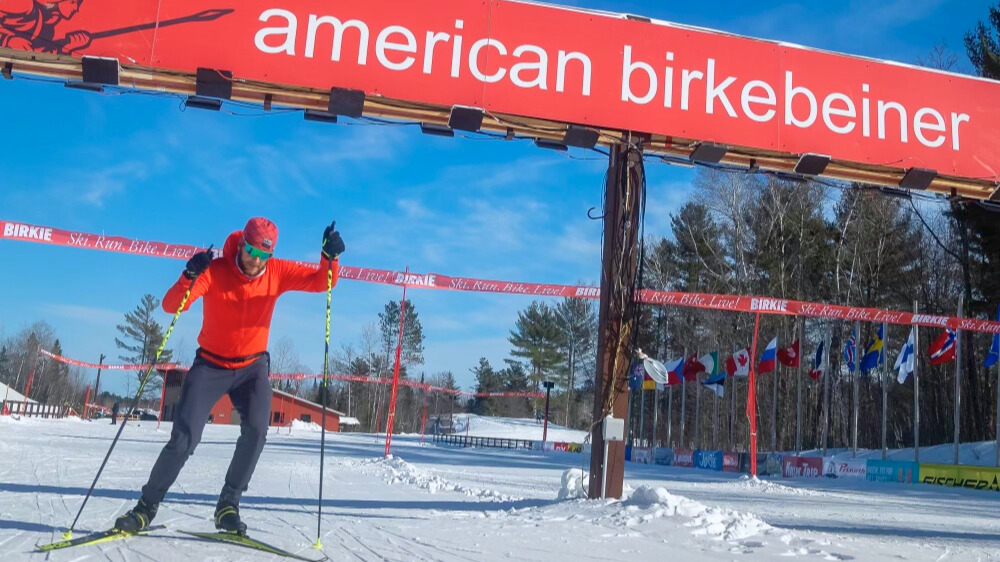It’s fitting that my first Birkie experience was on two fat tires rather than two skinny skis. I’d guess most people who line up amid the throngs of competitors for their first Birkie are taking part in the nordic ski race. The fat bike race is wildly popular by fat bike race standards, but is an order of magnitude smaller than the ski event.
Because I classify myself as a cyclist, the fat bike was a perfect entry point into the excitement that’s had in Hayward. Meanwhile, I wouldn’t classify myself as a skier. Or, I would, but I’m the skiing type that prefers wide skis, metal edges, and a chairlift escort up the mountain before the real fun begins.
I caught the Birkie fever that first time around, so fast-forward a few more years (and with the encouragement from friends), and there I was lining up for the traditional Birkie feeling very much like a fish out of water. Something must have gone horribly right, because I did well enough to earn a start in the elite wave my next time around, and I have been back to ski Wisconsin multiple times since my first foray into the Birkebein’ing.
Find Your Stride
With the experience I’ve gained in this realm, the question was recently posed to me, How does a cyclist prepare for the Birkie? My knee-jerk reaction was to suggest having a go at the cycling event. Admittedly that was my first attempt at fat bike racing, which I found ferociously and unexpectedly fast, so I then hedge towards the direction the question was likely intended, How does a cyclist prepare for the Birkie ski races?
An obvious first step is to be comfortable on skis. The graceful and efficient glide as displayed by those native with nordic skis comes with a lifetime of practice. Akin to swimming, a polished stroke or smooth kick goes hand-in-hand with having discovered the sport at a very young age. Formative years flailing (or honing) these movements are best executed when one’s age is a single digit. Adulthood makes this a much more challenging task.

Growing up in New Hampshire, I had hockey skates attached to my feet most weekends, and if that wasn’t the case, chances are I was buckled into alpine skis. The result is that I’m comfortable with the general concept of sliding across frozen surfaces. It’s still something I need to practice, remaining vertical on skis that are light as a feather and lack metal edges, but the general gist is muscle memory I understand.
Much like riding a bike, these movements are thankfully not forgotten overnight. Nor years. I discovered bike racing in my late teens, turned that into a career in my twenties and early thirties, which in turn means I sought warm weather during the winter rather than ice rinks and ski resorts. I didn’t dip my toe back into skiing until my late thirties when I was no longer contractually obligated to avoid “traditional winter sports.”
Recognizing that sprinting takes sharp, almost violent movements, all the while if you’re anything like me and at least some of your attention is being paid towards staying vertical, I suggest the pyramid approach. That is, spend the majority of your time at base intensity, then at ever increasing efforts, spend incrementally less time. In short: sprint just a little bit; ski at JRA pace (cycling-speak for “just riding along”) the majority of the time.
Fueling for The Birkie
My nutritional standpoint is the perspective of an athlete met with a sports nutrition company co-owner. Namely, as an athlete I want my nutrition to taste good and be easy to consume so that I’m inclined to take it down the hatch. As a business owner, I want it to be effective so that the user is reaching for more! I’ve been called the Pied Piper of maple syrup and UnTapped is the only nutrition I use. Ginger or Lemon Tea Mapleaid served hot in a thermal bottle keeps me hydrated during the arid winter months; UnTapped “gels” are maple syrup based, offering delicious, fast acting carbohydrates, vitamins and minerals in a predictable, non-gummy delivery. And the waffles are my favorite way to quench hunger on long days or are a tasty treat to reward a hard day when I return to the car.


Have Fun, Stay Warm, Be Comfortable
Lastly, looking the part. My nordic ski apparel is entirely winter riding gear, except for one pair of specific ski pants. I’ve grown comfortable in spandex for the better part of the past two decades in cycling but haven’t yet made the leap to full ski attire. As part of the gravel cycling scene, which harps a run whatcha brung mentality and cobbled together franken-bikes, attire for me is a bit of an afterthought. Without a doubt, there are aero gains to be had by wearing skin tight materials designed to cut through the wind on a cold day, but my goal first and foremost is to have fun, stay warm, and be comfortable on the ski trail. That’s all most of us need.
Hopefully these bullet points translate from cycling to skiing are helpful. After that, it’s just a matter of honing that flail down the trail!
